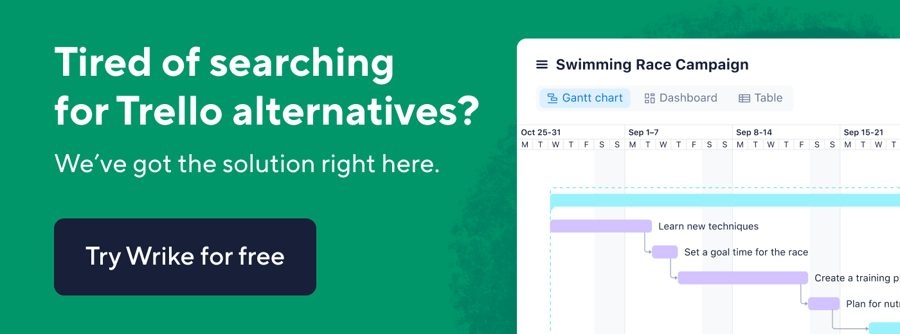Key takeaways:
- What are some reasons organizations seek Trello alternatives? Organizations often need advanced features like Gantt charts, workflow automation, or effective collaboration tools beyond Trello’s basic Kanban functionality.
- Which project management tool stands out as an alternative to Trello? Wrike is highlighted as a robust, customizable platform particularly suited for larger teams and complex projects.
- How does Wrike enhance collaboration compared to Trello? Unlike Trello, Wrike integrates communication tools and allows project-wide discussions, improving team collaboration and efficiency.
- What are key features of Wrike that surpass Trello’s offerings? Wrike provides built-in resource planning, budgeting tools, advanced analytics, and comprehensive reporting capabilities, facilitating better project management.
- Why is Wrike considered scalable for growing organizations? Wrike supports unlimited projects while maintaining clarity, along with customizable views and over 400 integrations to adapt as team needs evolve.
Many organizations that search for Trello alternatives do so because:
- They want something more than a basic Kanban board. Kanban is Trello’s speciality, a simple and easy-to-use visualization that’s made the project management software popular. However, if you want true Gantt charts, built-in workflow automation, or other more sophisticated features, Trello won’t be able to help.
- They’re working on more complex projects than Trello can handle. Trello’s strength is its simplicity. But when you’re working on many parallel projects across teams, departments, and physical locations, the platform might not be robust enough.
- They need more detailed planning or reporting. With Trello, you can’t really do resource planning or basic project management tasks such as time tracking without external integrations. Plus, Trello’s native reporting is quite limited too.
So, what’s the best alternative to Trello? Which advanced project management tool should you use instead? In this guide, we share 13 alternatives to Trello, so you can find the right collaboration tool to suit your needs. We show you how their features work compared to Trello and what you can expect when using them.
We start with Wrike, our fully customizable project management platform, used by the likes of Siemens Smart Infrastructure and Sony Pictures Television.
It’s easy to make the transition from Trello to Wrike. Book a demo to find out how.
1. Wrike: The best Trello alternative for larger teams
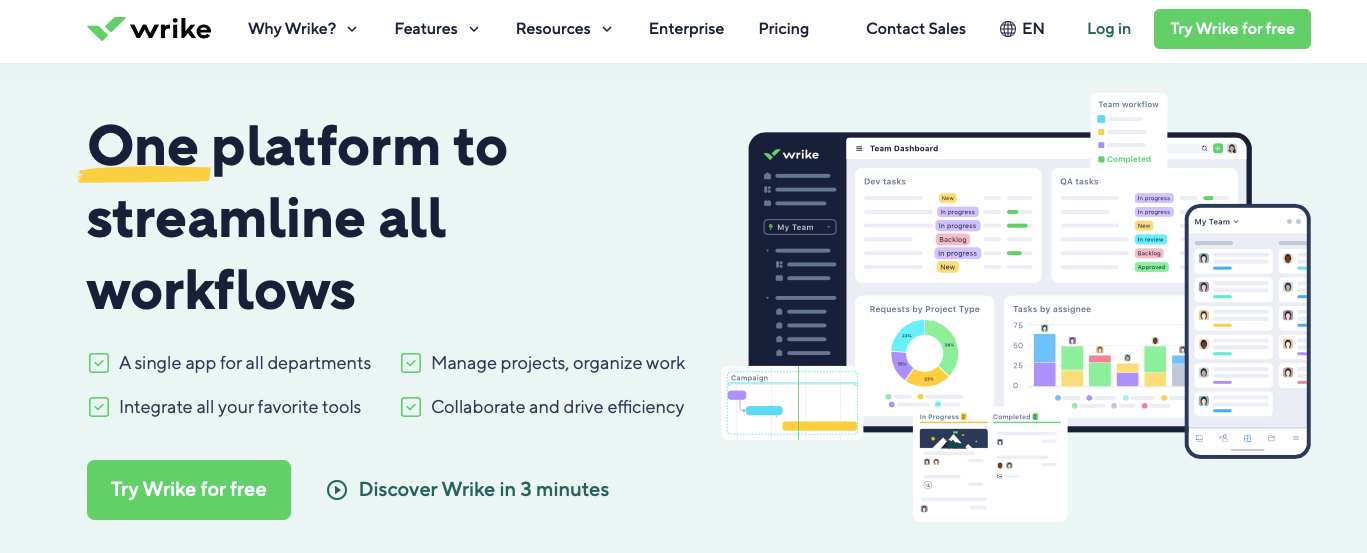
Wrike is our scalable and robust project management platform. Teams often make the change from Trello to Wrike when they’re looking for a tool that can handle larger or more complex projects.
In fact, over 2.4 million people use Wrike in over 20,000 companies across the globe. Plus, our software has repeatedly been named by Forrester as a leader in collaborative work management.
We think that Wrike is better than Trello for three key reasons:
- Wrike gives you much more choice about how to customize your projects.
- It makes it easier to collaborate with colleagues.
- It lets you plan and report on projects all in one place.
Let’s explore these factors in more detail.
Wrike lets you visualize your projects however you like
What makes Wrike really stand out among project management solutions is how customizable it is. In comparison to Trello, Wrike does a lot more than just Kanban boards (although we have those too).
Instead, no matter how you want to work, Wrike lets you track and see your projects in a way that makes sense for you. Plus, it lets you scale up to manage unlimited projects in one platform, without things getting cluttered.
- Wrike has its own intuitive Kanban board view. Track project progress by changing the status of tasks, just like in Trello. Wrike gives you the option of Kanban if that makes sense for you, while letting you chat about entire projects (not just individual tasks).
- Wrike gives you a deeper view of task dependencies with customizable Gantt charts. When Kanban isn’t enough, switch over to Wrike’s Gantt Chart view. This gives you a complete understanding of task dependencies, milestones, and due dates. While Trello is primarily a task management tool, Wrike gives you insight over your entire projects.
- Wrike provides user-friendly personalized dashboards for every single colleague. Every team member has their own workflows and to-do lists. With Wrike’s dashboards, they can immediately get visibility on their own priorities, checklists, notifications, tasks, and subtasks, within the context of your whole organization’s work.
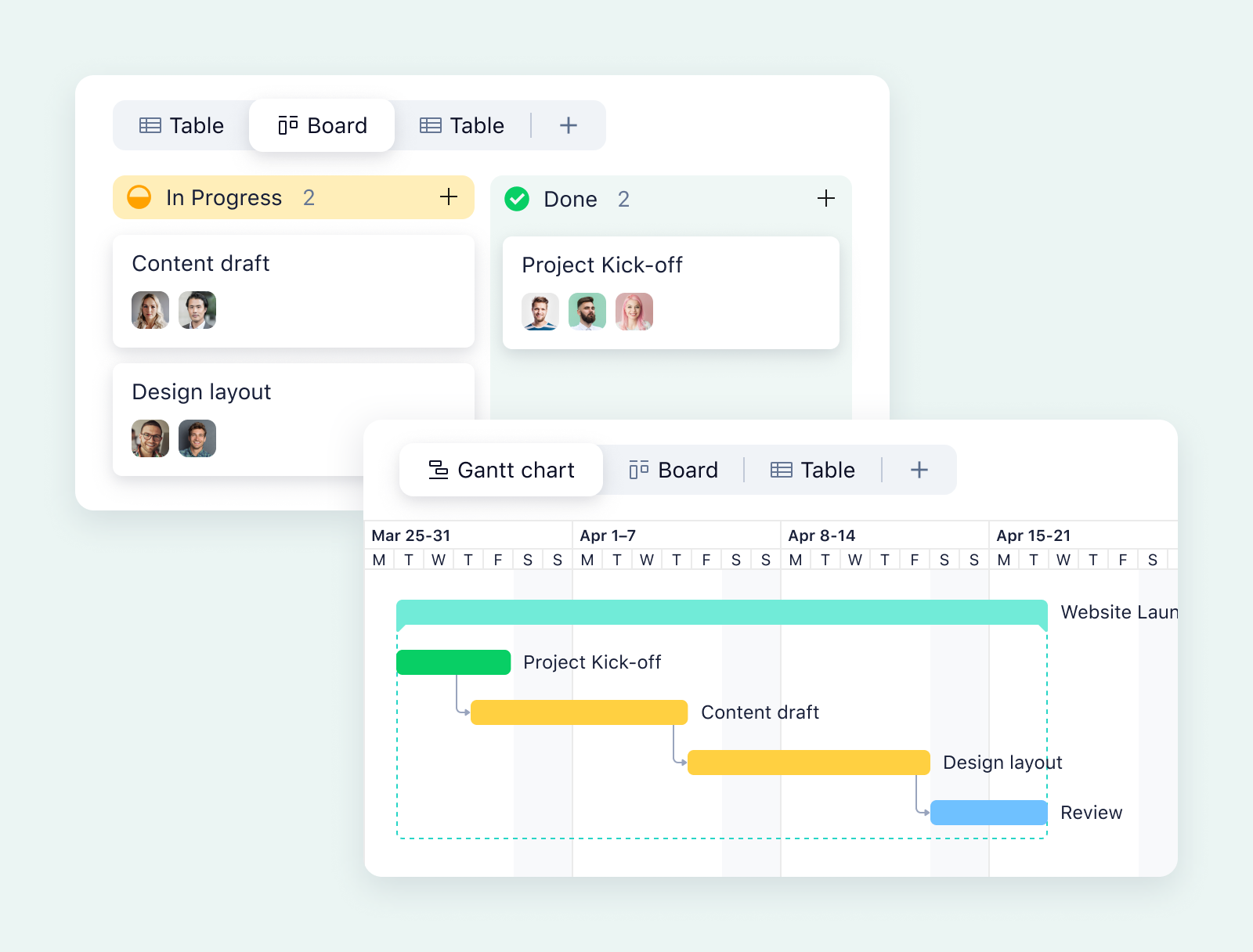
If you’re looking for an example of a company that made the switch from Trello to Wrike, look no further than Dodo Pizza. Since changing software, the company has improved its productivity by 200%.
“We started looking for a flexible project management system with certain features for Agile teams,” says Anastasia Detinkina, Delivery Operations Manager at Dodo Pizza.
We needed a tool that allowed us to organize marketing workflows and support development processes, such as prioritizing the backlog, managing sprints, and viewing work progress. We decided to choose Wrike as the platform since it met our requirements and needs.
Anastasia Detinkina, Delivery Operations Manager
Wrike empowers you to work together more easily with sophisticated collaboration features
There’s no doubt that Trello is really intuitive and easy to use for very simple projects (with very few people involved).
But when projects become more complex, you’ll find it lacks the advanced features that make collaboration easy. For instance, Trello only lets you comment on individual tasks — there’s no option for you to discuss entire projects, OKRs, or your business strategy.
On the other hand, Wrike brings everything you need for smooth and efficient collaboration into one place.
- Wrike lets you collaborate in context. With Trello, you do your work in one place and update your task statuses — and chat about work — in the Kanban board. The trouble with this is that your discussion about work is separated from the work itself. With Wrike, you can collaborate and discuss your work where it’s happening thanks to our native online proofing feature.
- Wrike unifies all your communication tools in one place. Tools like Trello work best only when used alongside communication platforms such as Slack or Outlook. This inevitably means your discussions are scattered across different channels. Instead, Wrike unifies them all, to keep critical information in one place. As a result, Wrike has allowed organizations such as Sony Pictures Television to reduce the number of emails sent by 90%.
- Wrike handles approvals from external stakeholders and freelancers. With Wrike, you don’t need to be an employee to join the discussion. For instance, you can notify freelancers and external clients who can quickly provide feedback and approve work.
- Wrike clarifies how complex projects relate to each other. Individual projects or tasks shouldn’t be seen in isolation. With Wrike, you can see how different projects affect each other with cross-tagging. It provides everyone with a better sense of how their work impacts that of others.
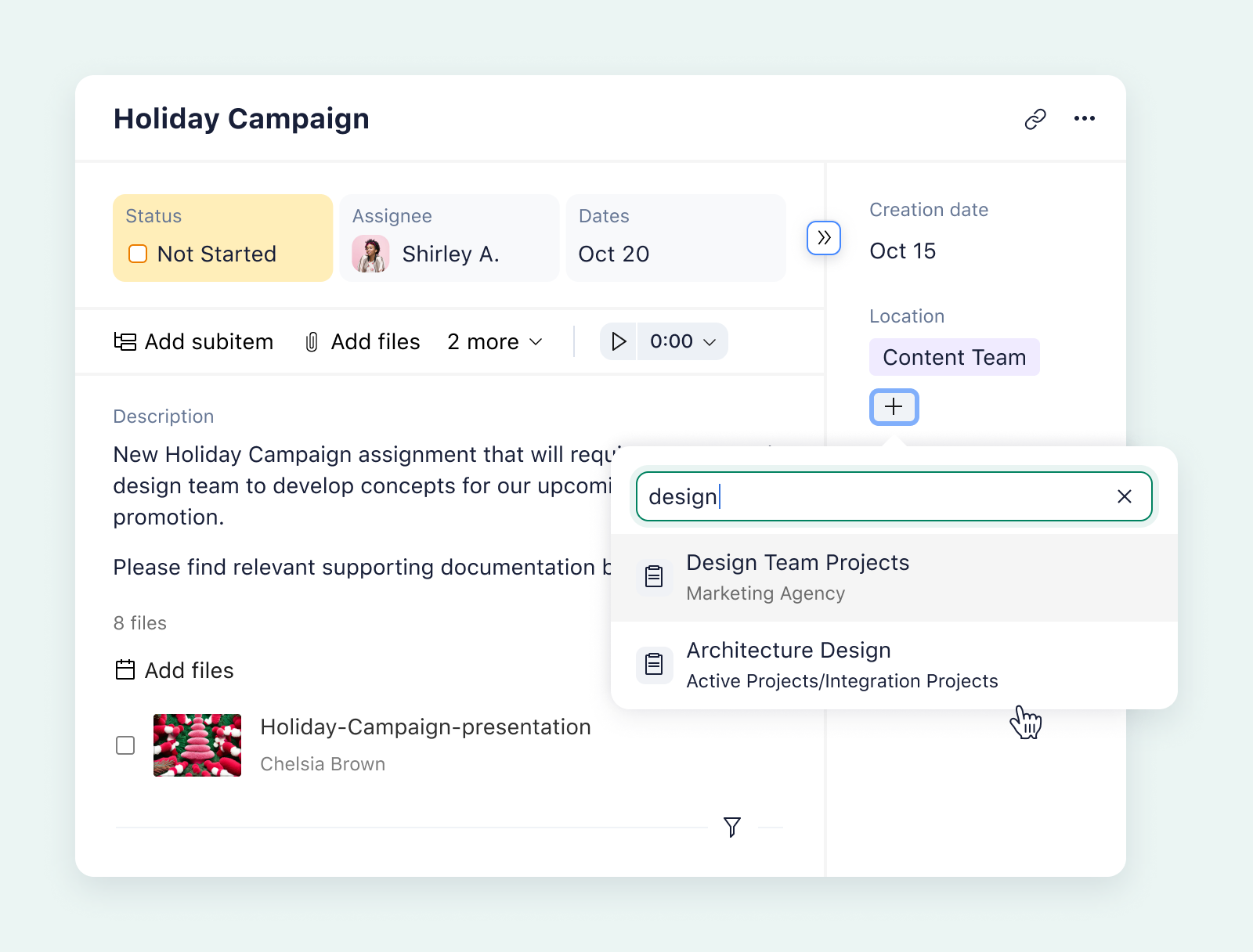
Wrike lets you plan and report on your projects all in one place
When it comes to ease of use, Trello excels. But what it offers in simplicity, it lacks in functionality. The reality is that some key project management features are simply missing.
Alternatively, at Wrike, we’re confident our platform has everything you need for effective work management, from resource planning to reporting.
- Wrike helps you meticulously plan and manage your resources. Track employee capacity, timesheets, and more in our platform. Plus, you can store everything your teams need to work — docs, wikis, or other assets — within Wrike too.
- Wrike can automate your workflows. Streamline your work intake by customizing request forms to gather all the information you need from the get-go. You can even generate a dynamic response, create tasks, initiate projects, and automate workflows — all from one flexible form.
- Wrike has built-in budgeting tools. Track employee hours, assess real spend against projections, stay on top of invoicing, and report on costs — all in one place.
- Wrike gives you sophisticated reporting on all price plans. High-performing teams need much more than basic metrics. Show off your hard work with reporting dashboards featuring detailed insights and infographics — available on all paid plans, not just top-tier enterprise options.
- Wrike assesses project risk to prevent disruption. Wrike helps you identify risks to your project delivery. With our Work Intelligence® solution, Wrike forecasts which projects are most likely to face disruption, based on the performance of previous projects.
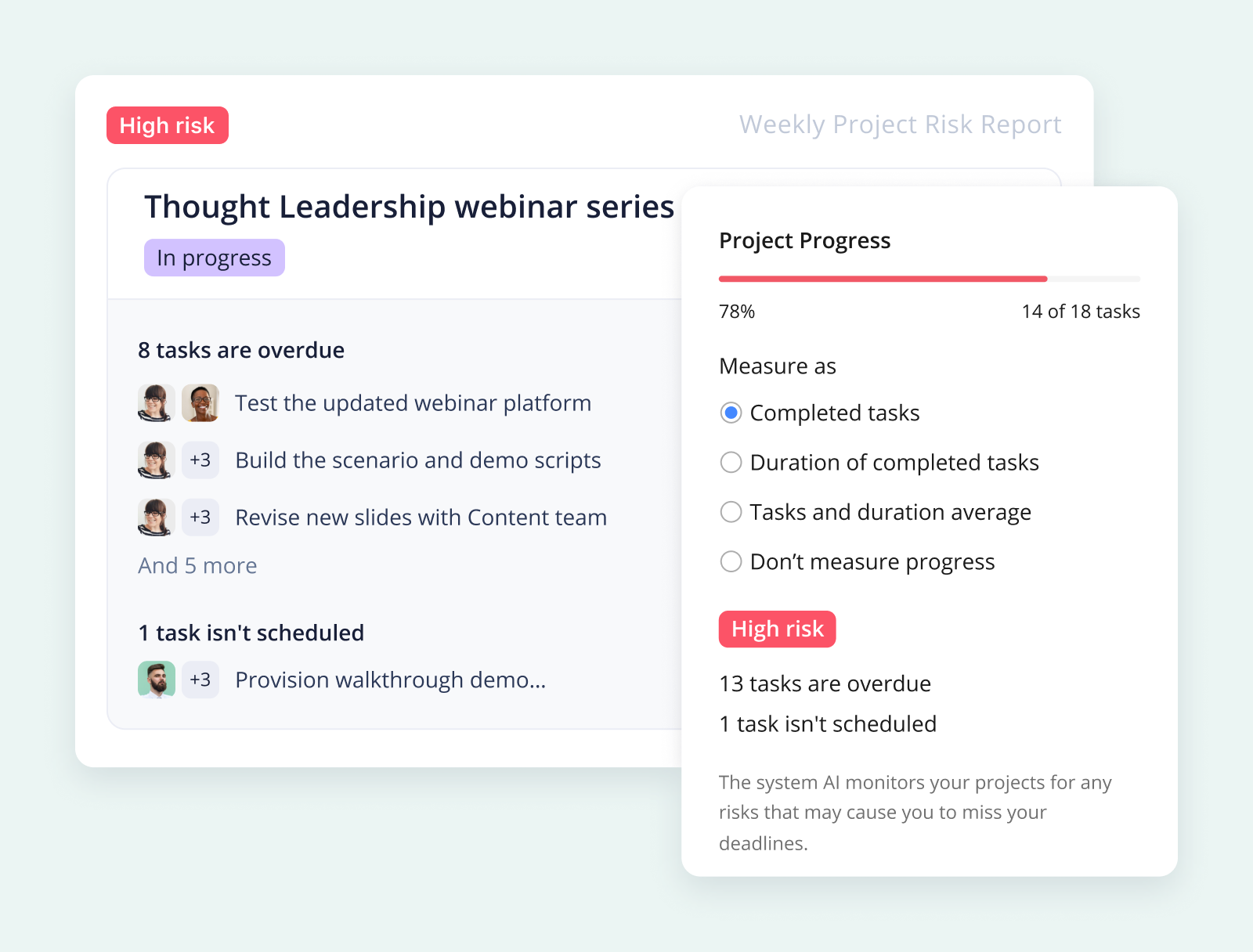
Sonance, an architectural speaker and outdoor audio manufacturer, came to Wrike when it was struggling with its resource management. With 18 product categories and more being developed on a regular basis, employees worked across business lines, products, and teams for engineering, development, and launch projects.
The Director of Product, Derick Dahl, tried many different project management tools, such as Microsoft Excel, Teamwork, Smartsheet, and more. But when he discovered Wrike, he knew it was the right fit.
Wrike’s resource management capabilities helped bring the product lifecycle management process and methodology that’s part of the DNA of our company to life, and it’s just incredible.
Derick Dahl, Director of Product
2. Asana: A Trello alternative for simple project management
Asana is one of the best-known project management platforms out there, designed to help team collaboration by organizing work in one connected space.
It’s used by millions of people worldwide and has some 200 ready-made integrations (compared to Wrike’s 400+). Asana’s paid plans are also more expensive than Wrike’s, starting at $10.99 billed annually or $13.49 billed monthly.
Request forms are important to many teams, as they’re the origin of work initiation. Trello has limited functionality in this regard, but Asana’s request forms can be customized, automated, and embedded, which all add extra versatility for their teams. Wrike’s request forms can do all that, but also generate entire workflows, kick-starting preplanned projects and arriving automatically in an assignee’s to-do list.
Ultimately, many users choose Wrike over Asana and Trello because it offers a less cluttered user experience, increased visibility, and more powerful work management features.
3. Smartsheet: An alternative to Trello based on spreadsheet functionality
If you’ve been managing your work via spreadsheets, you may be drawn to Smartsheet when looking for a Trello alternative.
Much like Trello, Smartsheet’s cloud-based project management software helps team members visualize and organize their work. It offers a tabular user interface that will be familiar to teams who lean on Excel or similar tools. Its paid plans start at a reasonable $9 per month (billed annually) but teams needing any Wrike-style advanced functionality will need to upgrade to the Business or Enterprise plans.
A key feature that differentiates Trello from Smartsheet is native analytics. Trello offers plugins that can help provide insights and reporting assistance. But Smartsheet has some built-in features that allow users to analyze and create custom reports by grouping and filtering data.
That said, Smartsheet’s analytics do require some time and effort to set up (while Wrike’s project dashboards, advanced analytics, and instant reports can all be accessed in seconds).
Small teams that are attached to simple Kanban board tools or traditional spreadsheets will find themselves comfortable with Trello or Smartsheet. But as an alternative to both, Wrike is far more powerful, offering more flexibility, functionality, and opportunity for growth.
4. Jira: An app similar to Trello for software development projects
Jira Software, Jira Core, and Jira Work Management are all tools that help businesses and organizations manage their work and collaborate with colleagues. While Trello is aimed at all kinds of teams, Jira is primarily for software developers and Agile project management methodology.
While Jira’s free version makes it a great Trello alternative, both providers’ subscription plans are billed on a per user basis (from $5 per user per month for Trello if billed annually, and $8.60 per user per month for Jira). This makes it something to consider for small businesses and growing teams.
Many people don’t realize that Trello and Jira are actually owned by the same company — the Atlassian Group — which provides similar functionality across many of its products. Because of this, it can be tough to decide which platform to use. Both use a Kanban board as their main project view, but the level of complexity differs significantly: Trello is easier to use, but Jira offers much more context into project and task details.
5. ClickUp: A Trello alternative for teams who want broad functionality
Another of the most popular project planning tools, ClickUp is often cited as a strong option for free Kanban board software. It has solutions for many different use cases, offering automations, chat tools, templates, and more.
ClickUp offers a “free forever” plan boasting basic features such as Kanban boards. It also has three paid plans: Unlimited starting at $7 per user per month (billed annually), Business starting at $12 per user per month (billed annually), and Enterprise with an unspecified price.
When comparing ClickUp to Trello and other work management platforms out there, many users focus on proofing and approval capabilities. Trello allows users to add proofs to boards via a plug-in called PageProof, and ClickUp offers the ability to mark changes or leave comments on up to six uploaded file types.
Unlike Wrike, though, neither has approval tasks, HTML/web proofing, or native integrations with popular design tools such as Adobe CC or DAM platforms like MediaValet.
6. Basecamp: An alternative to Trello for simple visuals
Basecamp started life as a design firm and even though it has evolved into a work management and collaboration platform, it still has a nice, clean look that stays true to its roots.
It prides itself on rejecting complexity in favor of simplicity, and this will appeal to teams who have limited requirements. Those anticipating growth or expansion may need alternatives to scale, but Basecamp does offer good value plans, starting from $15 per user per month.
In terms of features, Trello and Basecamp are quite similar (particularly now that Basecamp has introduced what it calls “card table,” its version of a Kanban board). What Basecamp doesn’t do, though, is a Gantt chart view, which you might need if you’re looking to scale up the complexity of your projects.
If you’re comparing Basecamp with alternative project management software, you might be interested in knowing that both Trello and Wrike offer the use of a Kanban board free on their $0 plans, while Basecamp doesn’t have a free plan at all.
7. Monday.com: A Trello alternative for use case templates
If you’re looking for a Kanban tool, Monday.com will probably appear on your radar. It’s one of the better-known work management solutions on the market. Monday.com has a wide range of features such as dashboards, automations, Gantt charts, and Kanban boards.
Like Trello, Monday.com has a free plan (for up to two users). Its paid plans do have minimum users (or seats), which makes the starting price $27 per month when billed annually.
Where Trello and Monday.com differ is in the range of their offering. Monday.com includes more work management capabilities, such as resource management, in addition to the task management features Trello provides. It also offers a large number of ready-made templates for a variety of use cases.
While Trello views, templates, and budgeting plugins will help users visualize and organize their resourcing, Monday.com’s features have more configurability, including a status, time tracking, and people column to assign project tasks.
However, for a complete resource management solution, compare Wrike’s offering to Monday.com’s. Wrike’s 360° workload view allows users to drag and drop tasks, check budgets, and monitor progression to prevent delays and burnout. It’s a much simpler and more dynamic choice if your organization needs to maximize resources this year.
8. Workfront: A Trello alternative for Adobe users
Workfront is bound to pop up when you’re reviewing Trello alternatives. Owned by the creative powerhouse Adobe, the Workfront project management software is designed to help organizations manage projects, tasks, resources, and people.
Unfortunately, Workfront doesn’t list its prices, which can make it difficult to compare to other providers. It also doesn’t have a free plan, if you’re looking for a Kanban board free of charge.
The biggest contrast between the two is that Workfront is designed for enterprise-sized organizations, while Trello is often favored by smaller teams and startups. As a result, Workfront has a formal, business-like interface which some users might find complex and clunky.
Another key differentiator is built-in proofing and approval features, which Workfront offers, but Trello lacks completely. However, Trello offers more integrations than Workfront.
Flexibility is something that will stand out when comparing Trello vs. Workfront vs. Wrike, for example. Wrike is the most versatile solution on the market, best for teams seeking to customize, tailor, and shape their workspaces without the need for time-consuming training, complex coding, or endless back-and-forths to admins.
5 more Trello alternatives to consider
There are many more project management tools to choose from. If none of the above feel like the right fit for you, try one of the following:
- ProofHub: ProofHub is a simple and straightforward project management app. As its name suggests, it’s built primarily for proofing and approving materials. But it lacks some key features such as budgeting tools.
- Airtable: Airtable was born as a database software, and it still retains this character. As such, it’s much better suited to data-centric use cases.
- Taiga: Taiga is an open-source, self-hosted project management tool. It’s aimed primarily at software developers and designers, so you’ll find features for Scrum teams and sprints.
- Zapier: Zapier is primarily a workflow automation tool that helps you to improve efficiency in your team. It’s most often used to integrate different apps, but it also has project management features.
- Zoho Projects: A basic project management software by the creator of workplace apps, Zoho is easy to use and intuitive. But it won’t be able to break down more complex projects like Wrike can.
Try Wrike, the best project management software for larger teams
In this guide, we’ve introduced you to 13 of the top Trello alternatives. If you’re looking for a tool that’s highly customizable and that scales as you grow, choose Wrike.
- Wrike offers an all-in-one platform, including functionality such as time tracking, task lists, and project reporting as standard — with no plugins.
- We have supremely customizable views, including Kanban, Gantt, and calendar, as well as personalizable dashboards.
- Choose from 400+ integrations, including with GitHub, the Microsoft Suite, and Adobe Creative Cloud. If you need another integration, we can set that up with our API.
- There are multiple pricing plans (both free and paid) to suit your needs. From a free plan for one team to an enterprise plan for unlimited users, Wrike has the plan for you.
- Enjoy easy collaboration designed for small, large, and remote organizations alike. With Wrike’s mobile app for Android and iOS, in-context approval comments, and the ability to share tasks and projects across teams, users can stay connected 24/7 (even with external stakeholders).
If you want to see for yourself just how powerful Wrike’s platform is, book a two-week free trial today. No credit card, no commitment, no downloads needed — just easy access to the world’s most versatile project management software.





